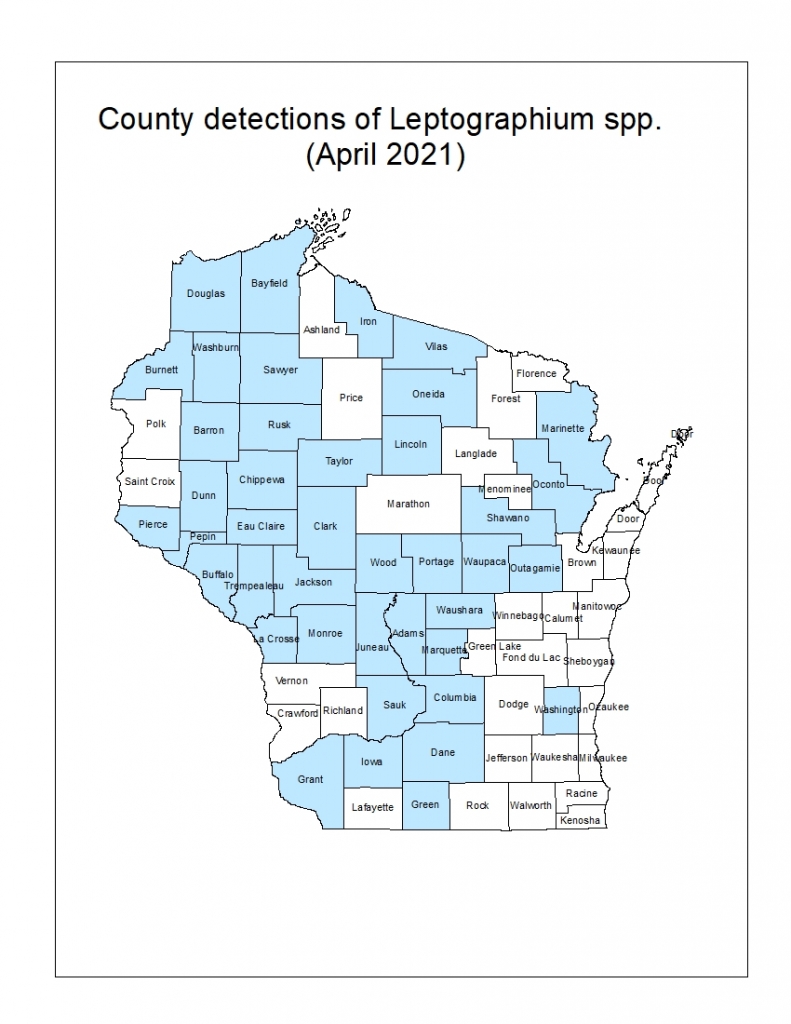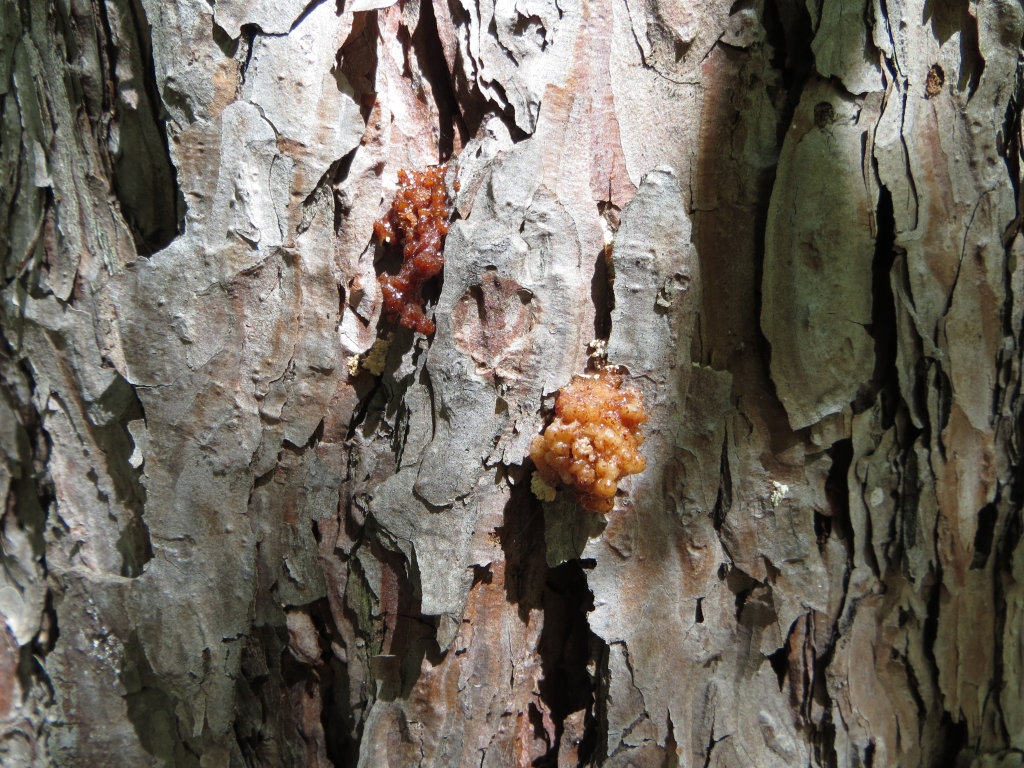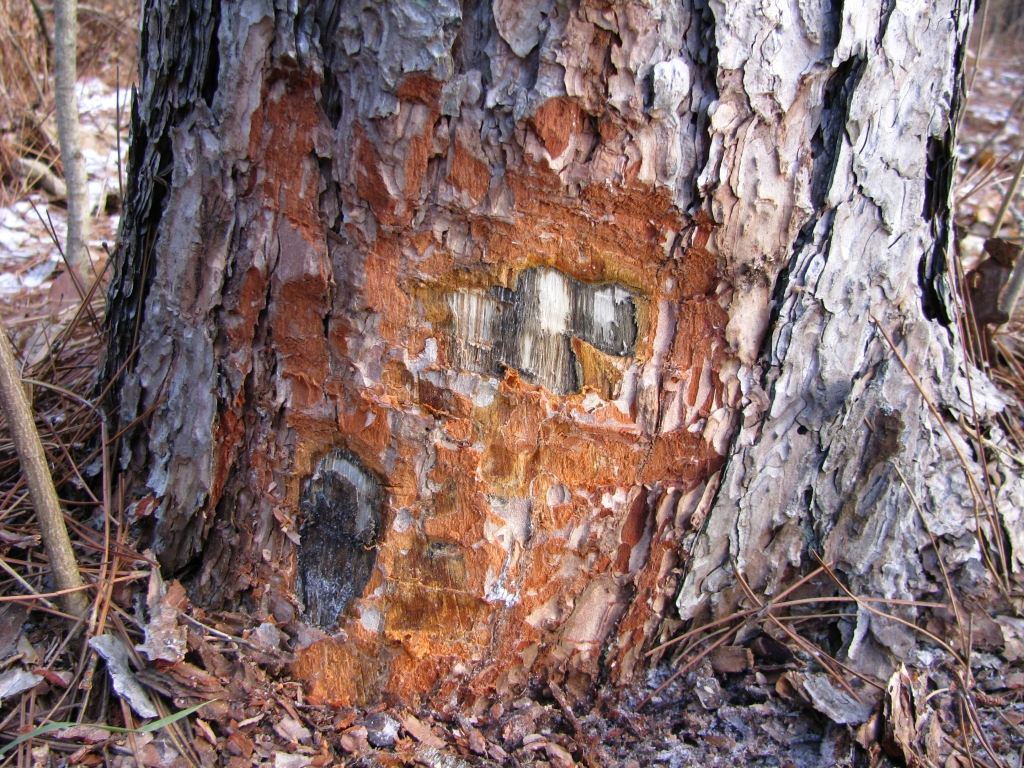Red Pine Pocket Decline and Mortality
Red pine pocket decline and mortality is a disease of plantation-grown red pine. The most likely trees to show symptoms of this syndrome are 30- to 45-year-old red pines in thinned plantations. Studies to identify the reasons why certain plantation sites have red pine pocket decline and mortality are ongoing.
More details on Red Pine Pocket Decline and Mortality can be found in this Wisconsin DNR fact sheet.
Distribution
Red pine pocket decline and mortality was first identified in Wisconsin in 1975. Currently, the DNR keeps a record of the county detections of red pine pocket decline and mortality.
County detections of red pine pocket decline and mortality
Pockets are more common in stands where trees have been cut than in unthinned stands because interconnected roots (root grafts) provide a pathway for the fungus Leptographium to move from tree to tree. National distribution of this syndrome is unknown.
Biology
Insects including root collar weevil (Hylobius radicis), pales weevil (H. pales), red turpentine beetle (Dendroctonus valens), pitch-eating weevil (Pachylobius picivorus) and Hylastes porculus feed on freshly cut stumps, the lower stem and roots of red pine and carry the fungi Leptographium terebrantis and L. procerum into the lower stem and root system.
Once settled in the shared root system of a red pine plantation, Leptographium spreads to healthy trees through root connections. Trees infected with Leptographium are stressed because they cannot take up and move water or make defensive compounds as well as usual. These stressed trees continue to attract lower stem feeding beetles, particularly the red turpentine beetle. Bark beetles (Ips pini and I. grandicollis) are ultimately responsible for the trees' death.
Impact
Infected trees have reduced height and diameter growth. As the disease progresses, pine bark beetles invade the tree and eventually kill it. The number of infection centers in a stand can vary widely. Infection centers create gaps in the forest canopy where brush and early successional trees can then grow.
Both Heterobasidion root disease and red pine pocket decline and mortality can occur in the same stand and even within the same pocket.
Trees killed by red pine pocket decline and mortality have NOT been seen in jack or white pine plantations. White pine growing up within pockets where red pine have died also appear to be unaffected by this syndrome.
Symptoms and Signs
Pockets typically start small, with one to a few dead trees surrounded by trees that have reduced shoot growth, yellowing leaves and thin crowns (fader trees). Each year, a few trees on the pocket edge may die and the edge of the pocket expands. Over time, pockets can become quite large (four-acre pockets have been seen).
Pitch tubes, which are signs of attack by the red turpentine beetle Dendroctonus valens, can be present on the lower bole of trees in the edge of the pocket.
The wood close to the pitch tubes and in the root collar area may be stained blue-black, caused by Leptographium spp. in the image above.
Exit holes of the pine engraver Ips pini are often evident on the dead trees within the pockets.
Management
There are several options for managing red pine pocket decline and mortality.
Option A
Leave the pocket as a natural opening.
Option B
Cut dead trees and trees that are showing dieback and/or yellowing of the foliage (fader trees) within and just outside the pocket.
This will not only capture wood value prior to the trees' death. It will also help reduce the population build-up of bark beetles in the stand. Bark beetle population increases dramatically during dry summers, especially when breeding materials are left on site. Breeding material includes recently cut or killed trees, stressed trees or logging slash greater than 2 inches in diameter. If cutting from March through August, it is recommended that logs and large slash be removed from the site within three weeks.
Option C
Cut dead trees and trees that are showing dieback and/or yellowing of the foliage (fader trees), and also cut a buffer area around the pocket.
Apparently healthy trees outside the pocket, extending one-half to one chain (66 feet) from the perimeter of the last fader trees, may be harvested to use the wood before the trees get the disease. A pocket created by red pine pocket decline and mortality often expands over time.
Based on field observations in central Wisconsin, it is estimated that a pocket expands one-half chain in five to seven years and at least one chain in 10-15 years. A clear-cut buffer area of one-half chain or one chain from the perimeter of the pocket can be created for a pre-salvage purpose. It is unlikely that creating a buffer area around the pocket edge will stop or delay the spread of a pocket created by red pine pocket decline and mortality. The distance that needs to be clearcut would be adjusted depending on when the next entry is planned and what your land use objectives are.
For example, if the next entry isn't planned until 15-20 years later, a larger clearcut buffer area may be preferred to capture wood value. On the contrary, if a landowner's primary land use goal is wildlife habitat or visual quality, clear cutting a buffer area may not be a preferred option or clear cutting a smaller buffer area may be a more attractive option.
Cutting fader trees will not only capture wood value prior to the trees' death; It will also help reduce the population build-up of bark beetles in the stand. Bark beetle population increases dramatically during dry summers, especially when breeding materials are left on site. Breeding material includes recently cut or killed trees, stressed trees or logging slash greater than 2 inches in diameter. If cutting from March through August, it is recommended that logs and large slash be removed from the site within three weeks.
Options D and E
Caution: Options D and E are highly experimental at this point. The effectiveness of these methods has not been proven. In addition, there are scientific articles that point out some negative effects of these practices (see below). We recommend you have discussions with a forester and/or a forest health specialist before you use these methods.
Option D
Cut dead trees and trees that are showing dieback and/or yellowing of the foliage (fader trees), cut a buffer area around the pocket and create root graft barriers around the buffer area by severing the root system.
Apparently healthy trees outside the pocket, extending one-half to one chain (66 feet) from the perimeter of the last fader trees, may be harvested to use the wood before the trees get the disease. A pocket created by red pine pocket decline and mortality often expands over time; based on field observations in central Wisconsin, it is estimated that a pocket expands one-half chain in 5-7 years and at least one chain in 10-15 years. A clearcut buffer area of one-half chain or one chain from the perimeter of the pocket can be created for a pre-salvage purpose. Root severing is done using a trencher (Ditch Witch) or a vibratory plow.
Wisconsin has done a large-scale field study to evaluate the effectiveness of root severing on the control of red pine pocket decline and mortality. Field data has been collected and the analysis and results of that data are still in progress. The University of Wisconsin and Wisconsin Department of Natural Resources worked together on the project.
Note: This method will create wounds on roots and may provide additional places for Heterobasidion root disease fungus to enter the trees if the fungus exists in the site. Thus it is not recommended in or near a stand where Heterobasidion root disease is suspected.
Cutting fader trees will help reduce the population build-up of bark beetles in the stand. Bark beetle population increases dramatically during dry summers, especially when breeding materials are left on site. Breeding material includes recently cut or killed trees, stressed trees or logging slash greater than 2 inches in diameter. If cutting from March through August, it is recommended that logs and large slash be removed from the site within three weeks of cutting.
Option E
Cut dead trees and trees that are showing dieback and/or yellowing of the foliage (fader trees), cut a buffer area around the pocket as described above and treat the stumps with a herbicide, such as Garlon 4 (Triclopyr), Tahoe 4E (Triclopyr) or other products that are labeled for cut surface applications.
Apparently healthy trees outside the pocket, extending one-half to one chain (66 feet) from the perimeter of the last faders, may be harvested to use the wood before the trees get the disease. A pocket created by red pine pocket mortality often expands over time. Based on field observations in central Wisconsin, it is estimated that a pocket expands one-half chain in 5-7 years and at least one chain in 10-15 years. A clearcut buffer area of one-half or one chain from the perimeter of the pocket can be created for a pre-salvage purpose. Herbicide treatment of the stumps may help kill roots and discourage the spread of the fungus, Leptographium spp. The effectiveness of this treatment on the control of red pine pocket decline and mortality is unknown.
Note: There are some reports that the use of herbicides may increase the risk of introduction and spread of Heterobasidion root disease. This treatment may compromise the management of Heterobasidion root disease, thus it is not recommended in or near a stand where Heterobasidion root disease is suspected.
Cutting fader trees will help reduce the population build-up of bark beetles in the stand. Bark beetle population increases dramatically during dry summers, especially when breeding materials are left on site. Breeding material includes recently cut or killed trees, stressed trees or logging slash greater than 2 inches in diameter. If cutting from March through August, it is recommended that logs and large slash be removed from the site within three weeks.
You are responsible for using chemicals according to the manufacture's current label directions. Not following label directions is a violation of federal law. Follow directions exactly to protect the environment and people from chemical exposure. Reference to a particular product is provided for the reader's information and is not an endorsement of one product over other similar products.
Other Options
Although rarely practical, removing freshly cut stumps will reduce feeding sites for the root collar weevil and the red turpentine beetle. These beetles are considered to be vectors that transmit the root disease.
Relationship to thinning
Red pine pockets are more common in thinned stands than in unthinned stands. The increased activity of the insects known to vector Leptographium spp., and/or the change in microclimate following a thinning, are likely related to the start of this syndrome in thinned stands.
Thinning is a necessary management tool used to maintain healthy and vigorous red pine plantations. Overstocked or very dense stands of red pine are more susceptible to attack by bark beetles. Thus, continue to thin red pine plantations as planned by a professional forester.
Relationship to mixed plantings
Red pine pocket decline and mortality has only been seen affecting red pine. Observations of stands where rows of white pine were mixed with rows of red pine have shown that pocket mortality is limited to red pine, even when growing close to white pine and other tree species. Consult with a professional forester regarding your options for mixed plantings.





